
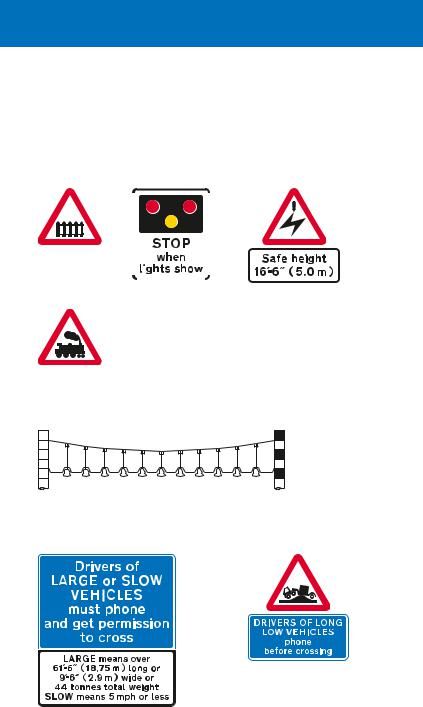
Level crossing signs and signals
Before the crossing
Level crossing |
|
|
|
|
|
||
with a gate or |
|
|
|
|
|
||
|
|
|
|
|
|||
barrier |
|
|
|
|
|
||
Plate used with |
|||||||
|
|
||||||
|
|
level crossing |
|||||
|
|
warning signs: |
|||||
|
|
advance warning |
|||||
|
|
of light signals at a |
|||||
|
|
level crossing with |
|||||
|
|
or without a gate |
|||||
Level crossing |
or barrier |
||||||
without a gate |
|
|
|
|
|
||
or barrier |
|
|
|
|
|
||
|
|
|
|
|
|
|
|
|
|
|
|
|
|
|
|
|
|
|
|
|
|
|
|
|
|
|
|
|
|
|
|
|
|
|
|
|
|
|
|
|
|
|
|
|
|
|
|
Electrified overhead cable and the safe height beneath it (usually associated with an overhead electrified railway or tramway). On the approach to a junction, the plate may include an arrow to indicate the direction of the level crossing
Bells suspended over the road at a railway crossing to give an audible warning to drivers of vehicles that exceed the safe height beneath electrified overhead cables
At automatic level crossings, drivers of large or slow vehicles must phone before and after crossing
Long low vehicles may be at risk of grounding; drivers of such vehicles must phone before crossing
26
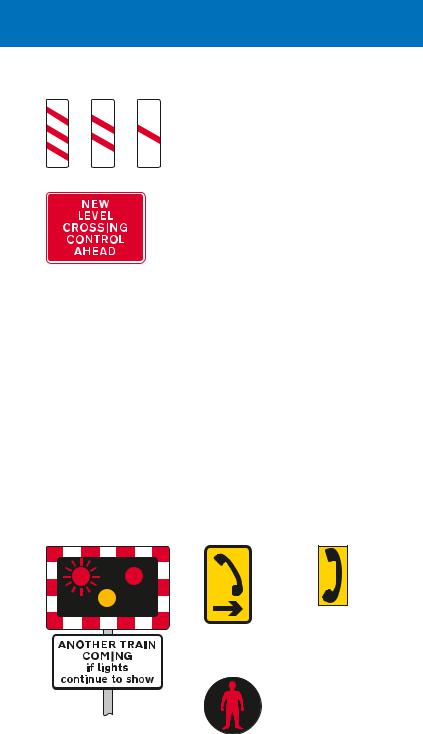
level crossing signs and signals
Countdown markers may be provided on the approach to a crossing. These divide the distance between the advance warning sign and the stop line into three equal parts; each sloping bar does not necessarily represent a distance of 100 yards
New method of controlling traffic at a crossing ahead (temporary sign)
At the crossing
Some crossings have flashing red road traffic signals; these mean STOP (and this applies to pedestrians too). A steady amber light shows before the red lights begin to flash, as at ordinary road traffic signals; this means STOP unless it is unsafe to do so. If the red lights flash for more than three minutes without a train arriving (other than at crossings with full barriers), or any barrier is lowered without the lights flashing, phone the signal operator. When the barriers rise, do not proceed until
the signals go out. If your vehicle breaks down or stalls on a crossing, get yourself and your passengers out of the vehicle as soon as possible. Phone the signal operator and follow the instructions given. Stand well clear of the crossing if the alarm sounds, the signals show or the barriers lower.
Direction to phone
Road traffic signals at a level crossing
Location of phone
Flashing pedestrian signals used at some level crossings indicate that it is not safe to cross: pedestrians should stop at the pedestrian stop line
27
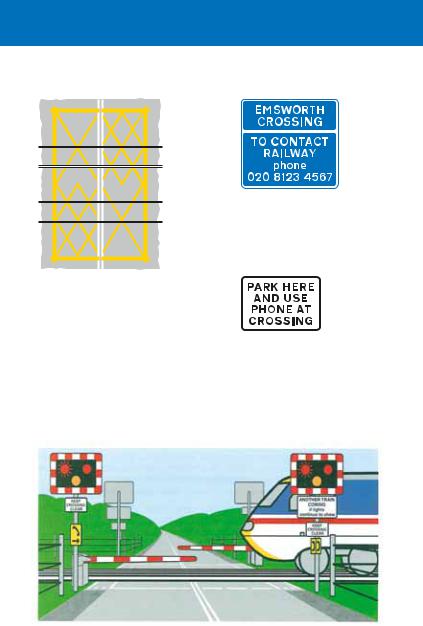
Yellow box markings indicate an area of carriageway at a level crossing that must be kept clear. Do not enter the box if other stationary traffic may cause you to stop with any part of your vehicle within the box
Name of level crossing and phone number for contacting the railway operator (at level crossings without a dedicated phone)
Place where drivers of large or slow vehicles should park near a level crossing while contacting the signal operator
Automatic half barrier level crossings
Amber lights and audible warnings followed by flashing red lights warn that a train is approaching and that the barriers are about to come down. You must STOP. The red lights flash all the time the barriers are down, but the audible warning might stop. If another train is approaching, the barriers will stay down; the lights will continue to flash and, if there is an audible warning, the sound will change.
28

level crossing signs and signals
Level crossings with miniature warning lights
Red  STOP
STOP
Green  Clear
Clear
IF NO LIGHT
PHONE SIGNALMAN
These level crossings have gates or barriers but no attendant. The miniature red and green lights are
operated by an approaching train. Full directions for using these crossings are given on roadside signs. You must stop even if the gates or barriers have been left open. Always close the gates or barriers after crossing.
Open level crossings
The St Andrew’s cross is used at level crossings where there are no gates or barriers. At automatic crossings, you must always STOP when the traffic light signals show. At crossings with “give way” signs, always look out for and give way to trains.
Automatic open level crossings have flashing signals and audible warnings. The lights will flash and the warnings will sound until it is safe to cross
If there is more than one railway line over an automatic crossing, this signal will also flash and the sound of the audible warning will change if another train is approaching
Open level crossings without gates, barriers or road traffic light signals have “give way”signs over a symbol of a railway locomotive
29
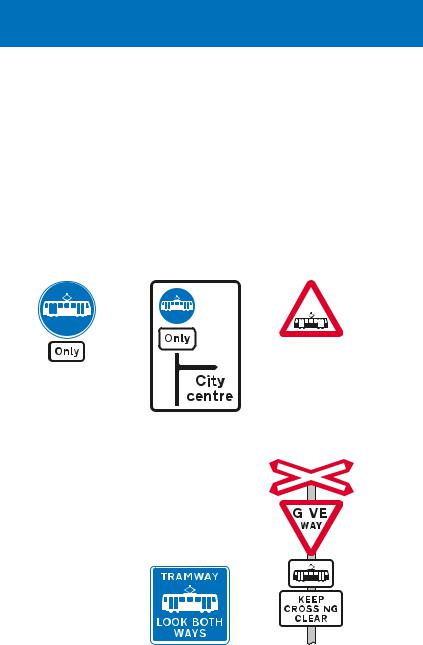
Tram signs, signals and road markings
Trams can run on roads used by other vehicles and pedestrians. The part of the road used by trams (the “swept path”) may have a different colour or textured surface to the rest of the road, or it may be edged with special road markings. Keep the “swept path” clear. Trams cannot move out of the way of other road users!
Route for trams only (and buses where the upper sign also includes the bus symbol)
Indication of a tram-only route at a junction ahead
Warning of trams crossing the road ahead
|
|
|
|
|
|
|
|
|
|
|
|
|
|
|
|
|
|
|
|
|
|
|
|
|
|
|
|
|
|
|
|
|
|
|
|
|
|
|
|
Road marking |
Reminder to |
Drivers of other vehicles |
|||||
indicating the |
pedestrians to |
must give way to trams |
|||||
start of a route |
look out for trams |
at level crossings |
|||||
for trams only |
approaching from |
without barriers, gates |
|||||
(and buses when |
both directions |
or road traffic light |
|||||
varied to TRAM |
|
signals. Sometimes just |
|||||
& BUS ONLY) |
|
a “give way” sign and a |
|||||
|
|
|
|
|
tram plate may be used |
||
30
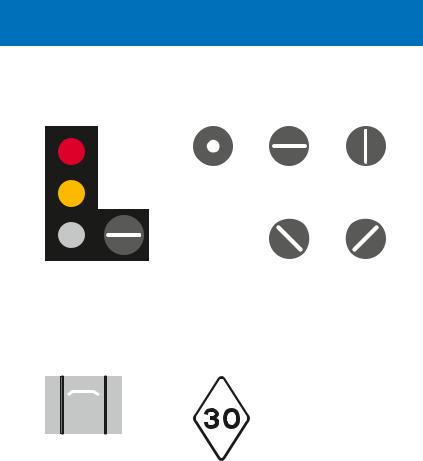
tram signs, signals and road markings
Examples of signs, signals and road markings for tram drivers
The signal mounted to the right gives instructions to tram drivers; these instructions may not be the same as those given to drivers of other vehicles
Stop unless |
Stop |
Proceed |
it is unsafe |
|
ahead |
to do so |
|
|
Proceed |
Proceed |
left |
right |
Stop line for trams at traffic signals where that part of the road is not used by other vehicles
Speed limit sign for tram drivers shown in kilometres per hour. All diamond-shaped signs are for tram drivers only
31
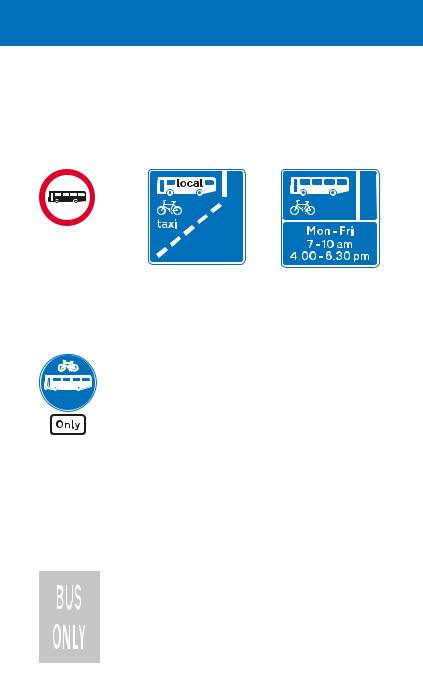
Bus and cycle signs and road markings
No vehicles designed to carry more than
8 passengers (excluding driver) or local buses
With-flow bus lane ahead that can also be used by pedal cycles and taxis. Hours of operation may be shown
With-flow bus and pedal cycle lane sign showing hours of operation
Route for buses and pedal cycles only (cycles not admitted when cycle symbol not shown; taxis admitted when “taxi” shown in upper sign)
The word “local” on the bus symbol means the only buses that may use the lane are those running a local service. Where the word “local” is not shown, the lane may be used by any vehicle designed to carry more than 8 passengers, excluding the driver, and local buses. Solo motorcycles may use the lane where the motorcycle symbol is shown on the signs (see page 141). Other vehicles may enter and stop in a bus lane to load and unload unless signs alongside the lane indicate otherwise.
Road marking indicating the start of a route for buses only. TAXI and/or the cycle symbol may be included
|
|
|
Bus lane |
Traffic may use both |
|
road marking |
lanes at the end of a |
|
|
bus lane |
|
32
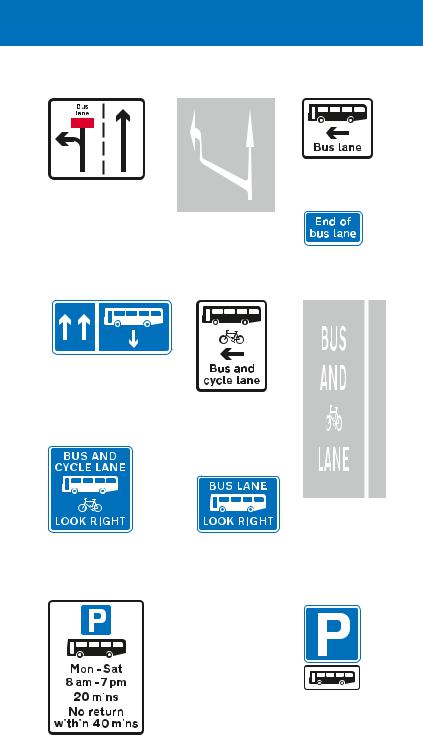
bus and cycle signs and road markings
Bus lane on road at junction ahead
Where there is a break in a bus lane at a junction, other traffic may use the left-hand lane for turning
left only
End of bus lane
Contra-flow bus lane (the upward arrows indicate the number of traffic lanes available)
Contra-flow bus and pedal cycle lane on road at junction ahead
Reminder to pedestrians to look out for buses or buses and pedal cycles approaching from the right
Road marking for a contra-flow bus lane that is also used by pedal cycles
|
|
|
|
|
Parking place for |
|
|
|
|
|
|
buses only, during |
Parking place |
|
|
|
|
|
times shown (with |
for buses only |
|
|
|
|
|
time limit) |
(no time limit) |
|
|
|
|
33
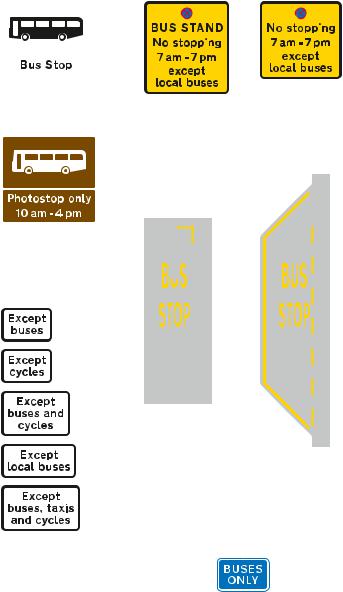
|
|
|
|
|
|
|
|
|
|
|
|
|
|
|
|
|
|
|
|
|
|
|
|
|
|
|
|
|
|
|
|
|
|
|
|
|
|
|
|
|
|
|
|
|
|
|
|
|
|
|
|
|
|
|
|
|
|
|
|
|
|
|
|
|
|
|
|
|
|
|
Stopping place |
|
|
|
|
|
Stopping by |
||
|
for buses |
|
|
|
|
|
|||
|
|
Place where local |
vehicles other |
||||||
|
|
|
|||||||
|
|
|
buses may stand, |
than local buses |
|||||
|
|
|
from which all |
prohibited during |
|||||
|
|
|
other vehicles are |
the times shown |
|||||
|
|
|
prohibited during |
|
|
|
|||
|
|
|
the times shown |
|
|
|
|||
|
|
|
|
|
|
|
|
|
|
|
|
|
|
|
|
|
|
|
|
|
|
|
|
|
|
|
|
|
|
|
|
|
|
|
|
|
|
|
|
Stopping place for tourist buses to allow passengers to take photographs
Edge of carriageway |
|
|
|
|
|
Edge of carriageway |
|
|
|
|
|
||
|
|
|
|
|
||
|
|
|
|
|
||
|
|
|
||||
|
|
|
|
|
||
|
|
|
|
|
||
|
|
|
|
|
||
|
|
|
|
|
||
|
|
|
|
|
||
|
|
|
|
|
||
|
|
|
|
|
|
|
|
|
|
|
|
|
|
|
|
|
|
|
||
|
Bus stop |
|||||
Bus stop in a lay-by
Plates used to indicate exemptions for buses, taxis and pedal cycles from prohibitions such as turn left ahead and no left turn. These signs may be circular when mounted in combination with traffic signals
The broad continuous yellow line at the edge of the carriageway means that other vehicles are prohibited from stopping
Entrance to a bus station, depot or garage
34
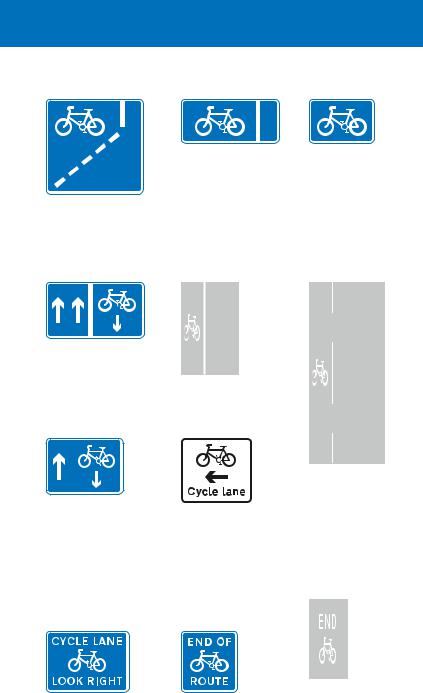
bus and cycle signs and road markings
Mandatory with-flow pedal cycle lane ahead. Hours of operation may be shown
Mandatory contra-flow pedal cycle lane (the upward arrows indicate the number of traffic lanes available)
Contra-flow pedal cycles in a one-way street (other than a mandatory contra-flow cycle lane). This may be marked by a broken line on the carriageway or there may be no line at all
Reminder to pedestrians to look out for pedal cycles approaching from the right
Mandatory with-flow pedal cycle lane. Other vehicles must not use this part of the carriageway except to pick up or set down passengers. Hours of operation may be shown
Road markings for a mandatory pedal cycle lane
Pedal cycle lane on road at junction ahead or (where “lane” is varied to “track”) cycle track crossing road at junction ahead
End of cycle lane, track or route
Route recommended for pedal cycles on the main carriageway
of a road. This may be marked as an advisory pedal cycle lane
Road markings for an advisory pedal cycle lane. Other vehicles should not use this part of the carriageway unless it is unavoidable
Road marking indicating the end of a cycle lane, track or route
35
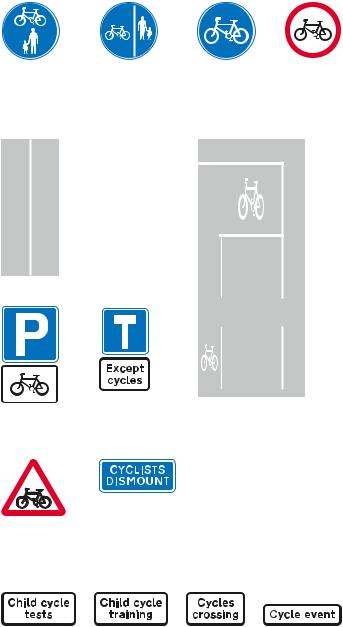
|
|
|
|
Shared route for |
Separated track |
Route for |
Riding of |
pedal cycles and |
and path for |
pedal cycles |
pedal cycles |
pedestrians only |
pedal cycles |
only |
prohibited |
|
and pedestrians |
|
|
Road marking separating cyclists and pedestrians on a shared route (may be a raised line up to 20 mm high)
|
|
|
|
|
No through |
||
Parking place |
road except for |
||
for pedal cycles |
pedal cycles |
||
|
Pedal cyclists to |
Pedal cycle |
dismount at end |
of, or break in, a |
|
route crossing |
cycle lane, track |
or joining road |
or route |
ahead |
|
Advanced stop line for pedal cycles at traffic signals. When the signals are red, drivers of other vehicles must wait behind the first stop line. If the signals change to red when a vehicle is crossing the first line, the driver must stop at the second line. Drivers should allow time and space for cyclists to move off when the signals change to green
Plates used with "cycle route ahead" sign
36
